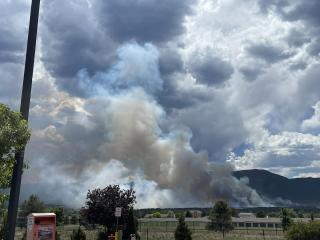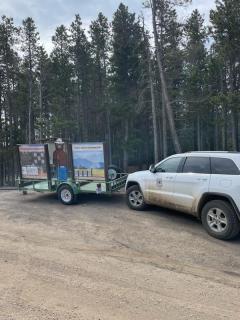Strengthening communities through prescribed burns
COLORADO — In early June, several columns of smoke rose from a prescribed burn project near neighborhoods on the western edge of Monument, Colo. After years of fighting large wildfires across the nation, smoke can become an unwelcome sight, no matter the ignition source. This year, staff has been hard at work attempting to change that outlook with help from Wildfire Crisis Strategy’s Colorado Front Range Landscape. After months of working directly with community members and partners, residents across the landscape are appreciative of the efforts and asking, “Where can we burn next?”
In recent years, the Arapaho and Roosevelt National Forests and Pawnee National Grassland and Pike-San Isabel National Forests & Cimarron and Comanche National Grasslands have been hard at work to increase the pace and scale of fuels treatment on Colorado’s Front Range. The forests have seen years of successful prescribed burning in the Wildland Urban Interface. However, this year, the operations have straddled forest boundaries and property lines, pushing prescribed flames and smoke closer to communities than ever before. Knowing this, forest communicators worked to keep the public informed, engaged and empowered at every step of the process.
Pre-season community engagement
Both the Monument Fire Center Prescribed Fire Project, on the PSICC, and the Forsythe and Magic Feather Prescribed Burns, on the ARP, targeted several thousand acres throughout the Front Range landscape. While the agency work for projects like these can take months or years of planning, the public may not know that operations are planned until they see smoke.
Knowing the proximity of these operations may raise concern, forest communicators decided to meet communities where they are. Prevention technicians and public information officers went door-to-door providing information in the neighborhoods closest to the burn units. By sharing information through conversation and informational flyers, the public was made aware of planned operations and given the time and opportunity to ask questions in advance of ignition.
To answer these questions on the PSICC, the unit hosted a series of community meetings for two months in advance of operations, continuing until the night of the first ignition. Through direct engagement, openness to questions and transparency about the process, communities in the area were empowered to better understand the work being done, resulting in a major tone shift from, “Not in my backyard” to “Me next!”
Additionally, both the ARP and PSICC have seen great community buy-in with field trips to burned areas. While these efforts have occurred before, during and after ignition, using them to connect public and on-site practitioners turned out to be a valuable tool for illustrating the benefits of prescribed fire to the land. Several of these field visits were planned and coordinated by partners, which allowed the conversations to address plans and potential beyond Forest Service boundaries.
Coordination and information at ignition
Due to the saturation of information, in several communities, educational resources from Forest Service outreach were being shared almost verbatim by business owners, community leaders and through local community-based social networking apps.
Building on the field trip model, staff from the ARP hosted a live prescribed fire field trip, inviting the public and media to attend as ignition began on the Magic Feather Prescribed burn. While weather conditions limited the success of ignition, the event was still an excellent opportunity to address questions on what goes into a prescribed fire operation. Attendees were appreciative of the opportunity to connect with subject matter experts and get answers to their most burning questions, pun intended.
Additionally, coordination with partners and local agencies remained essential to sharing information when the smoke began to rise. From amplified social media posts from local law enforcement to shared signage messaging with state agencies, the efforts from partners before and during ignition helped to limit 911 calls and kept traffic moving on major roadways.
Traditional fire communication methods were also highly beneficial. Staffing areas with public information officers, signage and sandwich boards, flyers and door hangers, social media posts and videos are critical to gaining support for the Wildfire Crisis Strategy and prescribed fire in the region.
Looking forward
The work did not stop when the smoke cleared. Interpretive signage and educational materials are being posted on-site in prescribed fire areas so that recreationists will be able see how the work being done is improving the landscape. The ARP’s Fire Prevention Team has a trailer at a popular trailhead leading into the Forsythe burn area that explains the project and its benefits. More long-term signage will highlight the benefits of prescribed fire.
Additionally, through their website, the Rocky Mountain Region has been helping residents increase their smoke literacy and live “smoke ready”. By centralizing resources on science, safety and information, these efforts will support the public in their search for timely information when smoke emerges.
Implications for the Wildfire Crisis Strategy
In a landscape traumatized by recent fire years, Forest Service staff have been working nonstop with local partners to communicate the benefits of wildfire risk reduction work, including prescribed fire and mechanical treatments. By expanding our efforts beyond partner organizations and directly to the doors of community members, we are ensuring that those directly impacted by the Wildfire Crisis Strategy are not only aware of, but largely in support by education, empowerment and ongoing conversations about forest health.
By sharing knowledge with our communities, we are inviting them to engage with the process and become advocates and experts themselves. Creating platforms for open, honest dialogue, be it face-to-face or through online platforms, has been very effective. By opening all lines of communication, we are addressing community concerns and creating a path forward where a common understanding can be reached. The groundwork laid this spring has set the forests up for continued success as they plan for future operations.



